Introduction
Animal breeding is a human activity probably as old as humanity itself. Iconographic documents help us get an idea of how farm animal species have evolved since the early days of domestication, at least for most external traits. In contrast, the history of ideas and practice implemented by man to change his domestic animals is far more difficult to trace. Animal breeding has for a long time been a collection of recipes, before progressively evolving into an art and then becoming a science.One American teacher, Jay Lush, in laying the foundations of scientific animal breeding, has contributed more than any other individual to the last step of this long evolution. Jay Lush taught animal breeding at Iowa State University (Ames, Iowa) from 1930 until his retirement in 1966 (see a brief biography by Chapman, 1991) His teaching and research resulted in a centre of animal breeding and genetics at Ames, that rapidly gained an international reputation and attracted students from all over the world.
In this article I will try to summarise the contributions of Lush’s ideas to the development of modern animal breeding and so I hope to explain the reasons why Lush’s influence on animal breeding around the world has been so profound.
Belonging myself to the long list of Lush’s students, I hope the reader will forgive my referring to some personal remembrances of the time I spent in Ames 51 years ago.
From Mendel’s laws to scientific breeding
Jay Lush is universally recognised as the father of scientific animal breeding. These are indeed the very terms employed in his Wolf prize citation of 1979. As such he holds a place of its own in the history of genetics and its application to agriculture. Lush’s position is rather unique at the interface between genetics and practical breeding. This may reflect contrasting situations between plant and animal breeding in the early days of mendelism. Plant breeding benefited much earlier than animal breeding from the rediscovery of Mendel’s laws and a number of scientists were actively involved from the early days of the 20th century in trying to apply genetics to plant breeding. Scientific plant breeding indeed developed in parallel in many countries, through the efforts of many scientists and in very diverse contexts. As pointed out by Roll-Hansen (2000), in a remarkable article on the impact of Mendelism on agriculture, the impact of Mendelian theory on plant breeding varied from country to country (see also Allen, 2000). A good example has been the contrast between Swedish optimism and British pessimism on the prospects for increasing grain yields. The careers of Correns and Tschermak in German-speaking countries, Bateson in Britain, Nilsson-Ehle and Johanssen in Scandinavia, and the activities of institutions such as the Royal Horticultural Society of London (founded in 1804), the Svalöf Institute in Sweden (1886) and the American Breeders Association (1903) offer examples of the variety of approaches in the application of genetics to plant breeding. France may also be mentioned as an extreme example of resistance to mendelism until at least the early 1930s. Among various explanations, Gayon and Burian (2000) point out the lack of interaction between academic biologists and plant or animal breeders. In contrast to plant breeding, animal breeding had long been waiting for principles to be used in practice. Lush got his “first intriguing glimpses of genetics” around 1914 (Chapman, 1991). The animal breeding then taught in agricultural colleges went as follows, Lush recalled: “The first principle of animal breeding was: like produces like; while the second principle was: like does not always produce like!” (Lush, 1951a).In this 1951 paper, abundantly commented upon 50 years later by a historian of science (Roll-Hansen, 2000), Lush exposed his “philosophy”. To him the most significant contribution of genetics was to dispel confusion and to bring clarity. As he wrote, with genetics “it became clear” that (i) identical pedigree does not mean identical heredity, (ii) genetic and environmental variation are both present in the individual but have quite different consequences for its descendants, and (iii) mutations are not so important in practical animal breeding. In another paper of the same year he notes: “The psychological effect of having the mystery dispelled from animal breeding and knowing that one was struggling only to utilize natural laws, rather than against capricious, unknown and possibly hostile forces, must have been considerable although no way to measure it is apparent (Lush, 1951b).
The fundamental breeder’s equation
Let us now ask ourselves: which contribution should we retain from Lush’s work in genetics, if we had to retain only one among many contributions? Would it not be the “breeder’s equation”? Lush himself, however, did not use that expression, neither was the equation even yet mentioned in the original 1937 edition of Animal Breeding Plans. I discovered the expression for the first time in the second volume of Lynch and Walsh’s treatise (see Lynch and Walsh 2nd volume website1), and I was so pleased with the term that I included it in my revised edition of Eléments de génétique quantitative (Ollivier, 2002). But I wonder whether we should not perhaps better call it “LUSH’s equation” and keep it in our records next to the well-known HENDERSON’s equations.Lush was essentially interested in changing things, through breeding plans based either on selection, relationship or somatic likeness. In fact, selection occupies more than half of the 17 chapters specifically devoted to breeding plans (Animal Breeding Plans, 3rd edition, 1945). There (page 148) he details the “increase expected in the population mean”, after having defined the selection differential as the “superiority of the selected parents”. In case all the genes combined their effects additively and the environmental variations did not affect the characteristic at all….. the expected increase in the population mean per generation would be equal to the selection differential. Actually the improvement of the population average will be only a fraction of the selection differential. That fraction has for its numerator the additive genetic variance and for its denominator the actual variance; i. e. the fraction is ó² G /(ó² G + ó² D + ó² I + ó² E) which for brevity we may call “heritability”. This statement is immediately followed by an example about fleece weight, and, having previously defined generation interval as the average age of parents when their offspring are born, Lush goes on predicting annual increase in the flock average.
The breeder’s equation in modern notation2 usually goes as R = ih², where R is the response per generation expressed in standard deviation unit of the trait of interest, i being the intensity of selection, or standardised selection differential, and h² the heritability. This equation can be compared to the famous “fundamental theorem of natural selection” of R.A. Fisher (1930), and Lush’s equation might thus be called the fundamental theorem of artificial selection. But I would like to point out another, considerably more far-reaching (if not extravagant) analogy, by moving to physics. We all know the famous equation promoted by Einstein’s theory: E = mc². As noted in a recent book on scientific curiosities (Aydon, 2005), the message embodied in this “ominous equation” can easily be understood by anyone with even a modest scientific education, since E stands for energy, m for mass and c² for the speed of light. This equation – remarkably the only equation in Aydon’s book: “it would not be a history of science if that one were left out” the author notes – tells us in simple terms the phenomenal amount of energy locked in the atom. One cannot help noting the “symbolic” similarity between R = ih² and E = mc²: one capital letter on the left-hand side and two minuscules on the right-hand side, the first being a variable (i or m) and the second a positive constant (h² or c²). And in both cases at the end much out of a little. A linguistic analogy can also be remarked since a breeder is a reactor in which breeding of fissionable elements takes place.
About the constancy of heritability (for a given trait), I should say that Lush was very cautious and he often insisted on the factors which could change h² (Lush, 1949), but he may have overemphasized the variability of this parameter. A long time ago, heritability of litter size in pigs – as estimated among many others by my colleague Legault (1970) – was 0.10. This remains the common figure that one can still find in the present day literature based on the most sophisticated tools of evaluation (Mérour et al., 2008). Alan Robertson and Oscar Kempthorne had a discussion at Ames in 1956, in a seminar where Alan was presenting the Edinburgh selection experiments and the derived concept of realized heritability. The discussion was about defining heritability in the narrow sense, in the broad sense, or in the “Edinburgh sense” (as John Wilson recalls). In this context it is worth noting that the way of measuring realized heritability is very precisely described, though not named as such, in chapter 8 of the 3rd edition of Animal Breeding Plans (Lush, 1945, p. 93). Being aware that we cannot do much to increase heritability, Lush found a way to “increase the speed of light” by combining individual merit and family merit (Lush, 1947). This 1947 paper, probably his most important single paper in his own words, is also a prototype for many of his papers. It illustrates how scientific knowledge can emerge from a very practical problem. Here the problem was to find how much attention should be paid to littermates when choosing boars and gilts for breeding (Chapman, 1991).
Changes
Lush was well aware of the really enormous possibilities of selection for changing things, given the slight changes to be expected in the rate of improvement predicted by the breeder’s equation. One change he described and quantified was the “narrowing of gametic array” generated by selection3 (Animal Breeding Plans, 1945 p. 142). This phenomenon, responsible for a decline in response, became later known as the Bulmer effect (Bulmer, 1971). Lush’s guess that the decline in the rate of progress should be “very slow” (Animal Breeding Plans, 1945 p.152) has since been amply confirmed by selection experiments on many organisms. He also emphasized the contrast between our “considerable ability to forecast the rate of improvement possible in the immediate future” and the lack of “techniques for estimation the genetic limits for any characteristic in any population, unless one knows what genes are present and knows their effects and frequencies” (Lush, 1951a). Limits have later been extended well beyond where Jay Lush may ever have imagined himself. As we know, genetics has gone a long way towards exploring the limits of selection, owing to the pioneer work of Alan Robertson in a field which considerably developed after him. But we are still in doubt about the reality of the “endless frontier” he postulated, even though we now know much more about gene effects and frequencies. Selection experiments on laboratory animals have shown the crucial role of population size. The ratio R50 / R1 (the selection response in generation 50 relative to generation 1) may be taken as a measure of deviation from linearity of response over a long period of time, and the value found in large experiments on Drosophila, R50 / R1 = 40, is not far from expectation when due account is taken of the Bulmer effect (Hill, 2008).Changes in the productiveness of animals were already well documented for many traits in many countries over periods of times extending far beyond the start of genetics, though the “taking of adequate and unbiased data is a distinctly modern development” (Lush, 1951a). Lush took as a first example of unbiased data the average weight of fleece per sheep in Australia, which showed an unmistakable upward trend, with a nearly doubled fleece weight over a period of 65 years (Figure 1A). As we can see, this trend has now been confirmed by a 5-fold increase in fleece weight over one and a half century (Figure 1B). In the US an increase of about 40 per cent of the production of farm animals was observed over the period 1920-1950, revealing quite an impressive steadiness (Lush, 1951a). But it was difficult to separate the trends observed into their genetic and environmental components. The first attempt to estimate genetic trends from field data may have been the study of production records from the Holstein-Friesian herd of ISC covering the period 1938-1949, shown in Figure 2 (Lush, 1951a). We have now fairly reliable estimates of genetic trends and genetic progress for most production traits in the main farm animal species over long periods of time (see the broiler example of Figure 3). Some decline in fitness traits has generally been observed, but genetic variation still remains and examples of improvement programmes show that unfavourable trends may be reversed by subsequent selection (Hill, 2008).
Figure 1A: Trends in fleece weight of Australian sheep
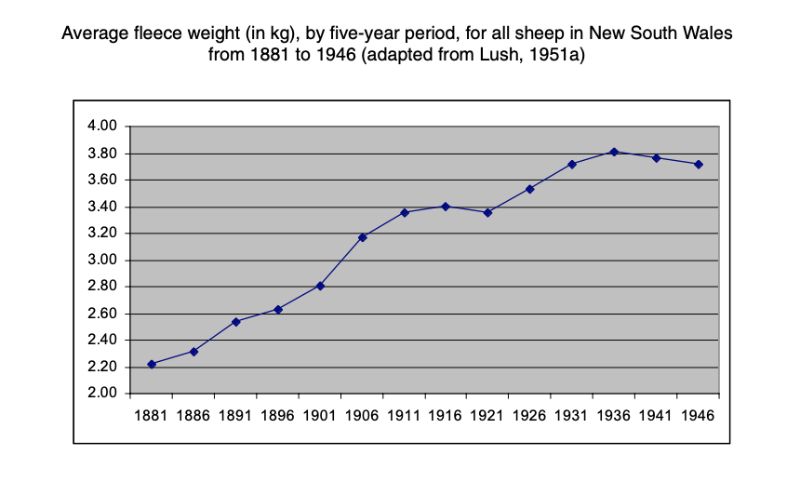
Figure 1B: Trends in fleece weight of Australian sheep (kg greasy per head) from 1850 to 2000
(from Rowe and Atkins, 2004; courtesy of Kevin Atkins).
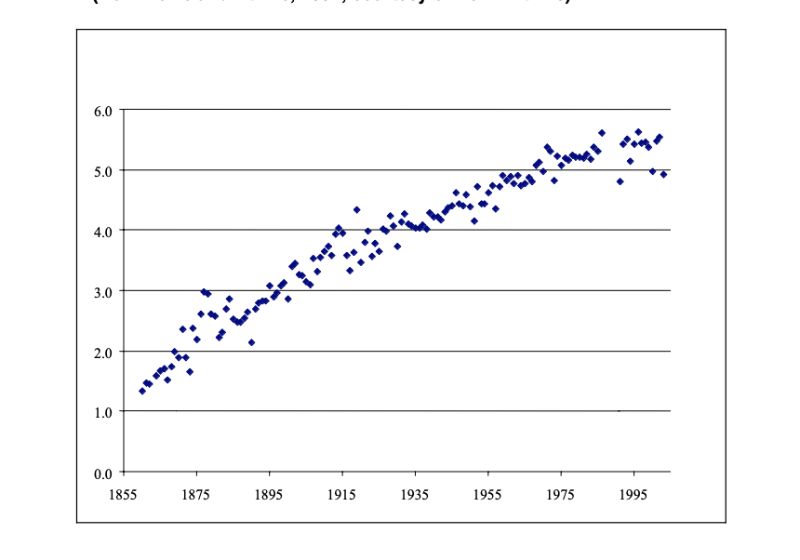
Figure 2: Phenotypic and genetic trends in 8-month fat production (kg) in the Holstein-Friesian
herd of Iowa State College over the period 1938-1949 (adapted from Lush, 1951a).
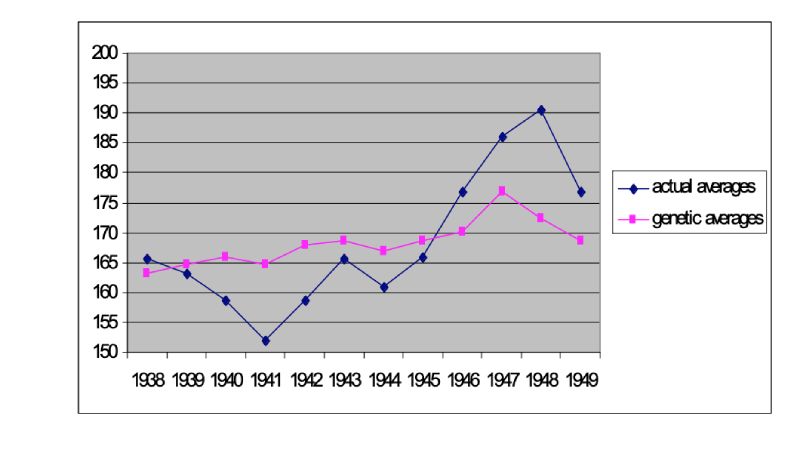
The blue line in figure 2 connects the actual averages and shows a trend of 2.7 kg/year. The red line connects the annual averages corrected by „fitting constants“ for year-to-year changes in environment and shows a trend of 1.1 kg/year.
Figure 3: Genetic changes since 1957. The broiler example (adapted from Hill, 2008).
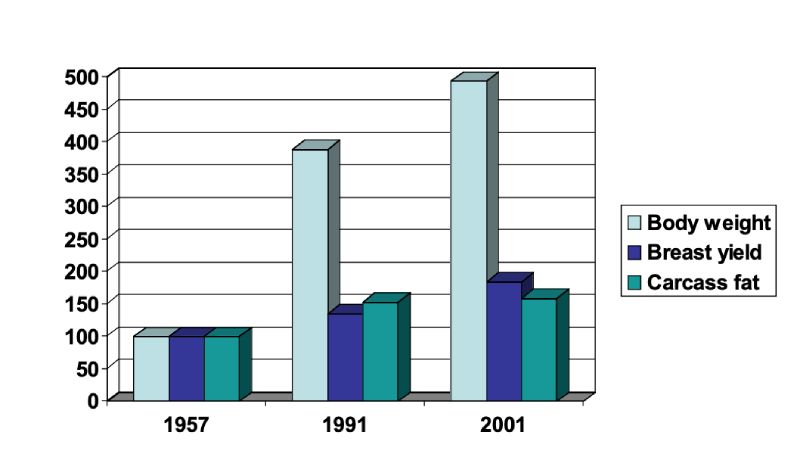
Lush’s legacy
The enormous impact of Jay Lush on the development of animal breeding internationally should again be recalled. The two essential ingredients behind his success are well known, (i) a famous book (Animal Breeding Plans, 1937, re-edited in 1943 and 1945, and translated in several languages) and (ii) a renowned teaching, based on mimeographed notes posthumously published (Lush, 1994). The link with the industry has been established through a sort of “human chain” made of his 279 students coming from 42 States of the Union and 32 foreign countries (Willham, 1999). Lush’s views on teaching and the balance he recommended to keep between research and teaching may be rather clearly perceived in the following quotation, which also, I believe, highlights his modest overall approach to science and the extreme precaution he always took before issuing scientific statements: “Immediately on completing my PhD degree, I did research for more than 8 years, with almost no interruption for teaching. I’m glad it happened that way. If I had taught the same course as much as three times in succession, using the available texts and my graduate notes and all the rest of what I thought I knew, I would surely have come to believe those things myself so firmly that the errors among them could scarcely have been corrected by any amount of subsequent experience…Having no papers to grade or class rolls to call, I listened… Usually the animals were saying something like: Most of the things you think you know may be true in principle but you have many of them out of all proportion to their actual importance…Trying to solve apparent inconsistencies drove me in the direction of measuring more accurately the factors in the problems…” (Lush, 1973).France may serve as an example of the development of animal breeding in Europe after World War II. France, however, presents some idiosyncrasies as to its relation to genetics, as it offers an example of a sort of “genetic lag”. We have already mentioned the resistance of the French biologists to mendelism. The first chair of genetics in a French university was indeed created at the Paris Sorbonne after World War II, whereas several European countries had already created chairs of genetics in the years 1910-1930 (Gayon and Burian, 2000). Research in animal breeding started in the early 1950s at the Institut National Agronomique in Paris under the leadership of Jacques Poly, who eventually founded the Department of Animal Genetics of INRA (in 1963) and later became Director General of this research institution (created in 1946). As Jean Boyazoglu recalls, Jay Lush enjoyed many visits to INRA as well as riding across the narrow roads of the French countryside, humorously commenting on the dangers they entailed. Lush also had INRA in great esteem, as Tom Sutherland recalls from his decision to go on sabbatical to Jouy-en-Josas following Lush’s recommendation. Owing to an inventory initiated by Jean-Jacques Lauvergne (Hutin and Lauvergne, 1964), the French scientific production in animal breeding has been thoroughly monitored ever since its beginning in 1952. Between 1952 and 2000, the annual number of scientific papers increased from two to 104 (Fig. 4A), the total count of contributing authors from three to 434 (Fig. 4B). The seemingly exploding number of authors (Fig 4B) reflects the general evolution in animal breeding research towards more international involvement and a corresponding number of authors per publication.
Hazel, Kempthorne and some others
Lanoy Hazel deserves a special recognition by the animal breeders’ community. Who else did ever produce three so fundamental papers over the course of only three years? His most famous 1943 paper on selection index (Hazel, 1943) came one year after a basic study of multivariate response to selection (Hazel and Lush, 1942), and was followed one year later by what may be seen as the first attempt at manipulating selection intensity, selection accuracy, and generation interval in order to maximise annual genetic response (Dickerson and Hazel, 1944). Hazel will also be remembered of course for being the inventor of the “mechanical measurement of carcass value on live hogs” using a backfat probe (Hazel and Kline, 1952). I later imported the method in France, which eventually allowed recommending a more efficient “performance testing” of pigs in lieu of the then popular progeny-testing, copied on the Danish model. This was like reversing the title of Dickerson and Hazel’s paper of 1944 by relying on the “effectiveness of early culling as a substitute to selection on progeny performance”. Incidentally, the year of Hazel’s discovery of the backfat probe happened to be that ofFigure 4: French scientific publications in animal breeding from 1951 to 2000
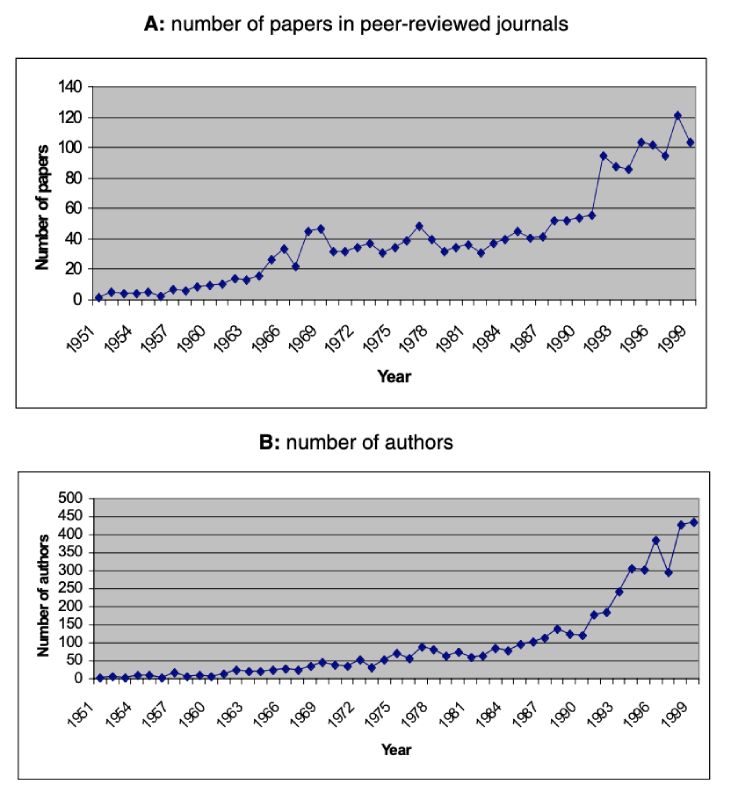
the construction by INRA of the first Danish-type pig progeny-testing station. It is hard to realise to-day the amount of skepticism that the method received from the French pig industry in the early 60s, before it became widely accepted.
I must pay tribute to the teaching of several outstanding ISC professors besides Lush and Hazel in animal breeding. Many of them were recognised “stars” in the related fields of statistics and “pure” genetics. Oscar Kempthorne certainly deserves a special mention. I still remember his warm welcome when I started my graduate work in September 1956, as he let me know straightaway how much he admired the French geneticist Gustave Malécot. Kempthorne actually introduced me to Les mathématiques de l’hérédité (Malécot, 1948), a small book that promoted an elegant theory of inbreeding and correlation between relatives from the concept of gene identity. The book, however, remained unnoticed by most geneticists until the publication of Kempthorne’s classical Introduction to Genetic Statistics. What Kempthorne said about the work of Malécot (Kempthorne, 1957, p. 72) applied, I believe, to his own teaching. Kempthorne’s guiding principle was indeed to “lay bare the crucial ideas untrammelled by unnecessary assumptions”. In his preface to Introduction to Genetic Statistics Kempthorne acknowledged the “tremendous inspiration” that Fisher’s writings had been to him. Nevertheless, he expressed his indebtedness “to Wright for his work on inbreeding and population genetics” and mentioned he was “also highly stimulated by mimeographed notes on population genetics by J.L. Lush”. Kempthorne’s course thus appeared as a most welcome complement to Lush’s teaching, essentially based on Wright’s work, though Lush actually benefited from personal contacts
with both Fisher and Wright4. A detailed account of the exchanges between Sewall Wright and Jay Lush, which started by a letter of Lush to Wright in 1918, is presented in the book of Provine (1986) Sewall Wright and Evolutionary Biology.
Let me also mention George Snedecor, whose Statistical Methods (Snedecor, 1956) I have religiously kept in my scientific library as a source of invaluable numerical examples for implementing standard statistical tests. John Gowen made me discover an astonishing laboratory beast, called Drosophila melanogaster. Gowen was a firm believer that most of the genes hypothesised to govern quantitative traits would one day be perfectly identified. As Tom Sutherland recalls, animal breeding graduate students of the time saw this contention as extravagant if not on the verge of insanity. The flourishing business of “gene hunting” which has steadily developed since the 1980s, and has now evolved into “genomic selection”, appears to have vindicated his belief. Gowen is also known as the editor of Heterosis (Gowen, 1952), a much quoted book ever since it came out in 1952. Among many remarkable papers, the book contains an article by Charles Henderson (ISC Ph.D. 1948) which extends Hazel’s selection index theory to a quite general method of breeding value estimation now known as BLUP, and even extends it to the “animal model” (Henderson, 1952, p. 359-361).
Conclusion
Going back to those 1956-57 days in Lush’s graduate school, I cannot help remembering the friendly atmosphere which reigned among the students then present around Professor Lush. Let me mention a few names: Chris Plato from Cyprus – so surely Plato was familiar with Lush’s thinking even though the reverse remains to be established – Niti Bohidar from India, Mohammed Gazzi from Egypt, Franz Pirchner from Austria, Werner Hartmann from Germany, Per Jonsson from Denmark, Tom Sutherland and Charlie Smith from Scotland, John Wilson from Northern Ireland, and Americans from many states in the Union. This geographic diversity was a reflection of Jay Lush’s principle not to have more than two graduate students originating from the same country. Let me particularly recall the memory of Charlie Smith, who has provided the field of animal breeding with so many new and exciting ideas. Lush’s influence on his students has been aptly summarised by Touchberry, quoted by Chapman (1991):”Dr Lush was highly respected and admired. He was firm without being threatening and he got his point and message across without raising his voice or using profanity. He was a warm and friendly person with a tremendous respect and tolerance for students”.The tradition of international openness that Jay Lush exemplified during his whole career at Iowa State has been continued ever since and is now enhanced with the launching of the Jay Lush Chair in Animal Breeding and Genetics, officially put in the hands of Dorian Garrick on 25 April 2008. All my best wishes go to the success of this initiative.
Allen, G.E. (2000): The reception of mendelism in the United States. C. R. Acad. Sci. Paris, Sciences de la vie 323: 1081- 1088.
Aydon, C. (2005): A book of scientific curiosities. Hachette Livre Australia, Sydney,
Bulmer, M. (1971): The effect of selection on genetic variability. Amer. Nat. 105: 201-211.
Chapman, A.B. (1991): Jay Laurence Lush, 1896-1982: a brief biography. J. Anim. Sci. 69: 2671-676.
Dickerson, G.E. and L.N. Hazel (1944): Effectiveness of selection on progeny performance as a supplement to earlier culling in livestock. J. Agric. Res. 69: 459-476.
Fisher, R.A. (1930): The Genetical Theory of Natural Selection. Clarendon Press. Oxford.
Gayon, J., and R.M. Burian (2000): France in the era of mendelism (1900-1930). C. R. Acad. Sci. Paris, Sciences de la vie 323: 1097-1106.
Gowen, J.W. (ed) (1952) : Heterosis. Iowa State College Press, Ames, Iowa.
Hazel, L.N. (1943): The genetic basis for constructing selection indexes. Genetics 28: 476-490.
Hazel, L.N. and J.L. Lush (1942): Efficiency of three methods of selection. J. Hered. 33: 393-399.
Hazel, L.N. and E.A. Kline (1952): Mechanical measurement of fatness and carcass value on live hogs. J. Anim. Sci. 11: 313- 318.
Henderson, C.R. (1952): Specific and general combining ability. In Heterosis, Gowen J.W. (ed). Iowa State College Press, Ames, Iowa, 352-370.
Hill, W.G. (2008): Maintaining genetic variation in fitness. In Adaptation and Fitness in Animal Populations, Evolutionary and Breeding Perspectives on Genetic Resources Management, van der Werf, J. H. J., R. Frankham, H. -U. Graser and C. Gondro (eds). Springer, Berlin (in press).
Hutin, C. and J.J. Lauvergne (1964): Liste des travaux de la Station Centrale de Génétique Animale (List of papers by the Central Station of Animal Genetics). Internal document, INRA, Jouy-en-Josas.
Kempthorne, O. (1957): An Introduction to Genetic Statistics. John Wiley and Sons, New York.
Legault, C. (1970): Etude statistique et génétique des performances d’élevage des truies de race Large White. II – Effet direct du verrat, héritabilité, répétabilité, corrélations (Statistical genetic analysis of reproductive traits of Large White sows. II- Boar direct effect, heritability, repeatability, correlations). Ann. Génét. Sél. Anim. 2: 209-227.
Lush, J.L. (1937, 1943, 1945): Animal Breeding Plans. Iowa State College Press, Ames, Iowa.
Lush, J.L. (1947): Family merit and individual merit as bases for selection. Amer. Nat. 81: 241-261 and 362-379.
Lush, J.L. (1949): Heritability of quantitative characters in farm animals. Proceedings of the Eigth International Congress of Genetics (Hereditas, Suppl. Vol., 1949, 357-375).
Lush, J.L. (1951a): Genetics and animal breeding. In: Genetics in the 20th Century. Essays on the Progress of Genetics during its First 50 Years, Dunn L.C. (ed). The Macmillan Co, New York, 493-525.
Lush, J.L. (1951b): The impact of genetics on animal breeding. J. Anim. Sci. 10: 311-321.
Lush, J.L. (1973): Teaching animal breeding and training graduate students. In Proceedings of the Animal Breeding and Genetics Symposium in Honour of Dr. Jay L. Lush. American Society of Animal Science and American Dairy Science Association, 178-188.
Lush, J.L. (1994): The Genetics of Populations. Prepared for publication by A.B. Chapman, R.R. Shrode and with an addendum by J.F. Crow. College of Agriculture, Iowa State University, Ames, Iowa. Special Report 94.
Malécot, G. (1948) : Les mathématiques de l’hérédité. Masson, Paris.
Mérour, J., E. Bernard, L. Canario and J.-P. Bidanel (2008): Analyse génétique de la productivité numérique et pondérale et de la durée de mise bas de truies Large White et Landrace français (Genetic analysis of litter size and weight, and of farrowing duration in French Large White and Landrace sows). Journées de la Recherche Porcine 40 : 133-136.
Ollivier, L. (2002) : Eléments de génétique quantitative. INRA éditions, Paris.
Provine, W. B. (1986): Sewall Wright and Evolutionary Biology. University of Chicago Press, Chicago.
Roll-Hansen, N. (2000): Theory and practice: the impact of mendelism on agriculture. C. R. Acad. Sci. Paris, Sciences de la vie 323: 1107-1116.
Rowe, J.B. and K.D. Atkins (2004): Strategies for lifting productivity in the sheep industry. Outlook 2004, Canberra.
Snedecor G.W. (1956): Statistical Methods. Fifth Edition. Iowa State College Press, Ames, Iowa.
Willham, R.L. (1999): On Jay Lush. In From Jay Lush to Genomics: Visions for Animal Breeding and Genetics, Dekkers, J.C.M., Lamont, S.J., and Rothschild, M.F. (eds). Iowa State University, Ames, Iowa, 141.
Zusammenfassung
Erinnerungen an Jay LushIm April 2008 fand an der Iowa State University in Ames ein Symposium „Lush Vision – Animal Breeding Plans“ aus Anlass der Einrichtung eines permanenten Lehrstuhls für Nutztiergenetik in seinem Namen statt. In dieser Übersicht wird die Persönlichkeit und wissenschaftliche Leistung von Professor Jay L. Lush (1896-1982) als „Vater der modernen Tierzüchtung“ gewürdigt. Sein Lehrbuch „Animal Breeding Plans“ wurde in mehrere Sprachen übersetzt, gilt als Klassiker auf diesem Gebiet und wurde einmal als „bedeutend, selbst für die, die es nie gelesen haben“ charakterisiert. Prof. Lush und seine Schüler in aller Welt haben durch Lehre, Forschung und Anwendung der wissenschaftlichen Erkenntnisse in allen Nutztierpopulationen maßgeblich dazu beigetragen, dass die Produktion von Lebensmitteln tierischen Ursprungs mit dem Bedarf einer wachsenden Weltbevölkerung schritthalten konnte.










